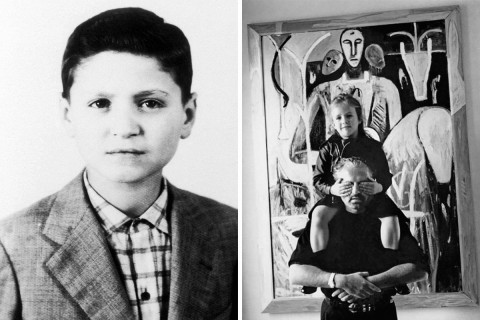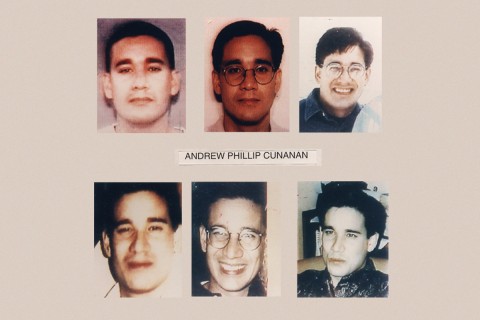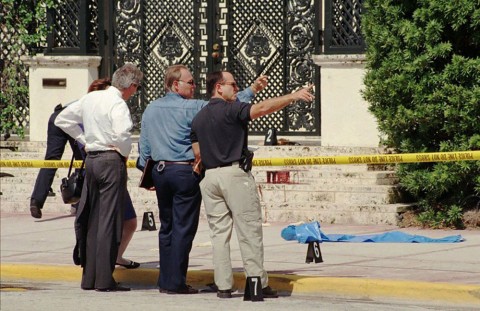It was supposed to be the culmination of a week of glorious and over-the-top catwalk shows in Rome for the biannual Alta Moda Alta Roma where for seven days straight, fashion elite, designers and celebrities had gathered to bask in the latest haute-couture offerings.
Despite the idyllic locale of the final show – on the Spanish Steps, perched down below the Trinità dei Monti church – the event was halted before it had even begun. Something terrible had happened 5,000 miles away which proved to be the culmination of a three-month killing spree that spanned four states and finished with a deadly flourish so noteworthy that it traveled across the Atlantic Ocean with the devastating impact of a hurricane.
Gianni Versace, the smiling, silver-haired figure who symbolized Italian fashion the world over, had been murdered in the early morning hours outside of his Vila in Miami Beach while unlocking the wrought iron gates outside of his sprawling compound.
An eyewitness, Eddie Biachi, said, “There were two shots fired in his head. The police came very fast; they were trying to help him, revive him.”
A good samaritan even tried to follow the shooter, but lost him amidst a maze of tourists as the man in question managed to escape down Ocean Drive.
In the moment, there was no reason to suspect that Versace’s murder had anything to with the trouble which had been terrorizing the gay community throughout the spring due to the exploits of Andrew Cunanan.
The killings that we know about began in late April of 1997 in Minneapolis. First, there was Jeffrey Trail, a graduate of the esteemed Naval Academy at Annapolis who worked as propane-company manager. He was found savagely beaten with a claw hammer and rolled up in a rug inside the loft of architect, David Madson.
Four days later, Madson himself was discovered near a rural lake – murdered with the .40-caliber handgun – that Trail himself had bought in 1996 while training to join the California Highway Patrol.
The Gay and Lesbian Anti-Violence Task Force in Minneapolis provided information gleaned from the gay community about the supposed killer, Andrew Cunanan, and websites catering to the gay community posted his picture and a warning about his “chameleon” personality.
The third victim, real estate tycoon Lee Miglin, was discovered inside a detached garage, tucked under a car and obscured by a trash can in his swanky Gold Coast high-rise in Chicago where his throat had been slashed and he died from repeated stab and slash wounds from a gardening saw.
There was en eery indication that Cunanan was at ease with the brutality – reportedly fixing himself a ham sandwich and shaving with Miglin’s razor before fleeing.
“He died a worse death than Christ,” Miglin’s 96-year-old mother, Anna, said when she heard about her son’s brutal slaying, according to family members who were shocked by the brutality of the details like his feet being bound together and his face being carefully wrapped in masking tape.
According to The Los Angeles Times, “With three dead and the FBI involvement in the case increasing, San Diego police searched Cunanan’s home, looking for dental charts that might be used to connect Cunanan with bite marks on victims or with the half-eaten food at the Miglins’ home. No dental records, or name of a dentist, could be found, but police did find something more ominous: two videos stashed under Cunanan’s bed produced by a West Hollywood firm and showing homosexual bondage and sadomasochism, including one episode in which a man is forced to wear a hood on his head while he is whipped and beaten.”
“It looked like a training film for the Miglin incident,” said one law enforcement official.
The fourth dead man, William Reese, a 45-year-old caretaker of a Civil War cemetery in New Jersey, became the first victim that seemed to have no motive other than Cunanan’s own need to steal his 1995 red Chevrolet pickup truck to evade capture and continue with his twisted odyssey.
Had spree killer Andrew Cunnanan stopped there, his name would probably be forgotten by now. However, he wasn’t finished.

Gianni Versace was born on December 2, 1946 in Reggio Calabria on the toe of Italy to a dressmaker mother, Franca, who had 45 seamstresses at the ready in her studio. Much like other prominent designers like Yohji Yamamoto who was also influenced by his mother’s profession, Versace was enamored with the process and how his mother could transform a person with her keen eye and attention to detail.
“Designing came to me,” Versace once said. “I didn’t have to move.”
After serving as an apprentice of sorts underneath his mother who cultivated his interests in fashion, Versace was eventually forced to leave his hometown and the convenience of creation with the matriarch of the family in favor of more opportunities to learn in Milan.

While many people may have sought to reinvent themselves and abandon all traces of home when venturing to a city 10 times as big as one’s hometown, Versace couldn’t leave behind the elements that made him who he was.
“When you are born in a place such as Calabria and there is beauty all around a Roman bath, a Greek remain, you cannot help but be influenced by the classical past,” he said.

Versace’s first major coup included becoming the chief designer for “Byblos” – a youthful extension of the already popular “Genny” line which was founded in Ancona in 1961 by Arnaldo Girombelli – which took its name from a hotel in Saint Tropez, and would foster not only the talents of Versace, but also Guy Paulin and the duo Alan Cleaver and Keith Varty.
Encouraged by his success, Versace presented his first signature collection for women at the Palazzo della Permanente Art Museum of Milan. His first fashion show followed in September of the same year and the first boutique was opened in Milan’s Via della Spiga in 1978.

Recognizing the importance of family when it came to cultivating a business, Versace turned to his siblings, Santo and Donatella, to help him run the newly-minted Versace empire.
“You can trust them,” he said of his family. “You can fight with them and be back in love. We can fight at 6 o’clock and have a nice dinner at 8.”

Prior to becoming the 449th fugitive to be listed by the FBI on the FBI Ten Most Wanted Fugitives list and having 400 FBI agents working on his case, Andrew Cunanan was the youngest of four children born in National City, California to a Vietnam War vet-turned stock broker father, and a homemaker mother.
Cunanan attended the prestigious Bishop’s School in the La Jolla neighborhood of San Diego where he earned a reputation of being not only one of the smartest people in the room (he spoke five languages), but also as a master manipulator who was confused about his own sexuality.
Following high school, Cunanan was known as “gigolo” and “party boy” as it related to gay nightlife around San Francisco’s Castro district who often introduced himself as “Andrew DeSilva,” a man with a factory in Mexico.
According to official FBI documents, “He had supplemented his earnings from an odd job here and there by serving as a male prostitute and engaging in longer-term liaisons with older homosexuals who would shower him with gifts and cash.”
While Cunanan’s motives are debated to this day, the FBI believes that he set out on his killing spree due to the belief that he had been infected by HIV/AIDS by either Jeffrey Trail, David Madson, Lee Miglin or Gianni Versace (although that theory is often discarded after the killer tested negative for HIV).
“If I had AIDS or if someone did that to me I would go on a five-state killing spree and take everyone with me I could,” Cunanan is quoted as telling friends before the spree began.
The first two victims were known associates of Cunanan. It’s believed that Madson actually helped him dispose of Trail’s body before he himself was murdered.
However, Lee Miglin’s family has always been adamant that their father never knew the killer.
“I can tell you unequivocally that we have not found a link between Andrew Cunanan and anyone in the Miglin family,” Matt Rodriguez, former Chicago police superintendent, said in July 1997.
According to several reports, the men were friends who on previous documented occasions paid a male prostitute for sexual services.
Cunanan and Gianni Versace were also known to have had at least one run-in with each other prior to the events of the morning of July 15.
According to Vanity Fair, “they had come in contact in a San Francisco nightclub, Colossus, in 1990; Versace was in town because he had designed costumes for the San Francisco Opera. That night, October 21, an eyewitness recalls, Cunanan was smugly pleased that Versace seemed to recognize him. ‘I know you,’ Versace said, wagging a finger in the then 21-year-old’s direction. ‘Lago di Como, no?’ And Cunanan replied, ‘Thank you for remembering, Signor Versace.’”
FBI agents told TIME that Cunanan and Versace probably did meet in San Francisco, though the nature of their relationship, if any, is still a mystery, and Cunanan and Versace definitely didn’t know each other from time spent at Lake Como.

It was perhaps Versace’s 23,000-square-foot, 10-bedroom Italian palazzo-style home featuring a 54-foot swimming hole lined in 24-karat gold tiles, mosaic walkways, fountains, balconies, statues, frescoes and golden bathroom fixtures which signaled his success as an entrepreneur to those outside of fashion circles.
Situated on busy Ocean Drive, a 15-block strip of Art Deco hotels and sidewalk cafes facing the oceanfront, Versace had a daily morning routine where he would walk four blocks to the News Cafe to buy magazines and a coffee.

“He walked past the entrance, circled back around and then went in,” said Stephanie Vanover, the News Cafe’s hostess. “It’s almost as though he knew someone was following him.”
Al Boza, a police spokesman, said Versace had been opening the gate to his home on Ocean Drive when he was approached by a “white male, aged about 25, wearing a grey T-shirt, black backpack and black shorts, and a white hat … who shot him at point-blank range.”

“The news of Gianni Versace’s death has left me in a state of shock,” said Italian designer Giorgio Armani. “Gianni Versace, together with a handful of names, symbolizes the success of Italian fashion all over the world. My reaction is one of revolt against such an unnatural and violent death, and one of profound grief.”
“There are no words to describe how I feel right now,” said designer Gianfranco Ferre. “What happened is absurd, unexplainable, terrible … I feel only infinite pain.”
American designer Calvin Klein said the fashion world “has lost one of the great designers of our time.”
Princess Diana issued a statement from the South of France, saying, “I am devastated by the loss of a great and talented man.”

Police tracked Cunanan’s movements to the Normandy Plaza Hotel, just a block down the road from the murder, where he had checked in on May 12.
According to the hotel’s owner, James Falin, investigators later seized a pair of electric clippers and some fashion magazines – many of which contained Versace advertisements – from Cunanan’s $39-a-night efficiency.
With the police drawing closer, Cunanan broke into a 25-ft. sailboat docked in Miami Beach and brought aboard a copy of Italy’s Corriere della Sera newspaper which many believe he obtained to read about his exploits in Versace’s home country.
Eight days after murdering Versace, Cunanan shot himself in the mouth in the upstairs bedroom of the houseboat – using the same gun he had used to kill Madson and Miglin.
Mourners gathered outside of Versace’s massive villa leaving behind copies of the Miami Herald and wrote “Debt settled” beside the front-page headline that read, “Manhunt Ends.”
-
Featured/Main Image:
Catherine McGann

